Creative Ways to Use Rugs in Kids’ Rooms Décor

Decorating a child’s room can be both an exciting and daunting task. While parents aim to create a space that is fun, stimulating, and cosy, they also need to ensure it is safe and functional. One of the most versatile items you can use in a kids’ room décor is a rug.
Not only do rugs add warmth and texture to a room, but they can also be used creatively to enhance the room’s theme, play a functional role in playtime, and even help organise space. This article will explore several creative ways to incorporate childrens rugs into your kid’s room.
Define Play Areas
A rug can effectively define play areas in a child’s room, particularly in small spaces that need to serve multiple functions. Use a brightly coloured or patterned rug to designate a specific area for play. This can help keep toys confined to one part of the room, making clean-up easier and maintaining more order throughout the rest of the space.
Create a Reading Nook
A soft, plush rug can be the foundation of a cosy reading nook. Choose a corner of the room and lay down a comfortable rug; add some cushions and a few shelves with your child’s favourite books. This designated reading spot will encourage your child to spend time reading and can serve as a quiet, comfy corner for relaxation.
Interactive Rugs
Some rugs come designed with games like hopscotch, cityscapes, or racing tracks, which can be a great way to stimulate your child’s imagination. These interactive rugs not only add a fun element to the room’s décor but also provide a built-in activity that can keep kids entertained for hours.
Enhance Room Themes
If your child’s room has a specific theme, a rug can enhance this motif. For a space-themed room, consider a rug with stars or planets. Look for rugs with animal prints or floral designs for a nature-themed room. A well-chosen rug can complement the room’s theme and pull all elements of the décor together.
Educational Rugs
There are childrens rugs available that feature letters, numbers, maps, and languages. These can help young children learn as they play. Position these rugs in the centre of the room, where they’re easily accessible for spontaneous learning through play.
Seasonal Switch-Up
These floor coverings can be an easy way to update a child’s room without major redecorating seasonally. Use light and airy designs for spring and summer, and warmer, deeper colours for autumn and winter. This not only keeps the room looking fresh but also can influence the mood and feel of the space throughout the year.
Layering Rugs
Layering rugs can add depth and texture to a room. Use a larger, neutral floor covering as a base and layer a smaller, more colourful or textured rug on top. This is particularly useful in creating a dynamic look in the room and can be changed or updated as your child grows and their tastes change.
Wall Art
Hang a decorative rug on the wall to serve as a statement piece. This can be an effective way to add warmth, texture, and soundproofing to the room. It’s also a safe way to include decorative elements in rooms where children play and might bump into things.
Photography Backdrops
For those who love capturing memories, a beautifully designed rug can be an excellent backdrop for photos of your little ones. Whether it’s for a formal photo shoot or candid daily pictures, having a designated spot with a visually appealing rug can make these moments even more special.
Soft Landing for Play
Lastly, rugs provide a softer surface that protects children from hard floors. In play areas, especially where kids are likely to tumble, crawl, or sit, rugs can offer a comfortable and safer place for all kinds of play.
Incorporating a rug into your child’s room décor is not only practical but also provides a host of opportunities to enhance and enrich the room’s environment. With creative placement and thoughtful selection, rugs can be much more than just a decorative item; they can be an integral part of your child’s everyday life, fostering play, learning, and creativity.
READ MORE:ARTICLEREADERS.ORG
[…] learn how to draw, huh? Fantastic! Drawing is not just about putting pencil to paper; it’s a way to express your creativity, relax your mind, and see the world through a different lens. Whether you’re doodling for fun […]